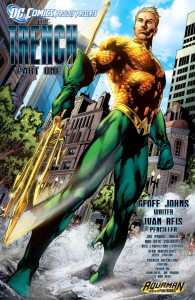
After reducing Aquaman to a hypothermic, hyposmotic, constantly famished, case study in psychological trauma, I figure that I owe the king of Atlantis a second chance. After all, Aquaman was and still remains the most interesting hero in the DC universe. A generous fan sent me a copy of Aquaman Volume 1: The Trench, arguing that the New 52 version of everybody’s favorite aquatic hero is even more compelling than previous incarnations, with a stronger backstory, powers that make sense, and plenty of humor.
Last time I paid the hapless mariner a visit, many readers interpreted my incisive criticism of the science behind Aquaman as evidence that I had it out for our scale-clad hero. Since you all know that I’m going to take the misguided marine science in this volume to task, let’s start with all of the good stuff in this reimagination of DC’s oft-mocked champion.
The central conceit of New 52 Aquaman is that the comic book world has the same perception of Arthur Curry that we do–a hero with oddly specific and mostly useless powers that talks to fish. In addition, the citizens of the DC Universe believe that Atlantis is a fairy tale, so Aquaman’s kingly status is meaningless to the surface dwellers. The hybrid of a human father and Atlantean mother, Aquaman feels out of place in Atlantis and chooses to return to the surface with his wife, Mera. Comparing himself to his lighthouse-keeper father, he explains that even though he loves the sea, someone must protect the shore.
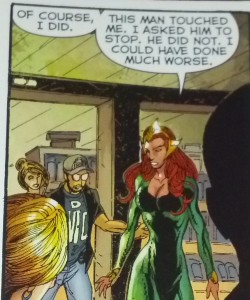
I love that the writer, Geoff Jones, takes the time early on to explain Aquaman’s powers, including his ability to command fish, super strength, near invulnerability, and few other attributes that put him on an equal footing with some of DC’s elite heroes. Aquaman is not a glory seeker and finds humor in the landlubbers low opinion of him. He is a hero confident in his powers, not seeking to prove himself to anyone. Likewise, Mera is a tough, no nonsense heroine. Although the standard tropes of female hero outfits are present, Mera is not two-dimensional. In her first adventure sans Aquaman, she explicitly establishes herself as a hero in her own right, and doesn’t tolerate being objectified.
Mera also gets the best line in the entire volume. While facing off against a villain who believes that Atlantean’s are powerless out of water, she responds: “The absence of water is not my weakness. It’s all of yours.”
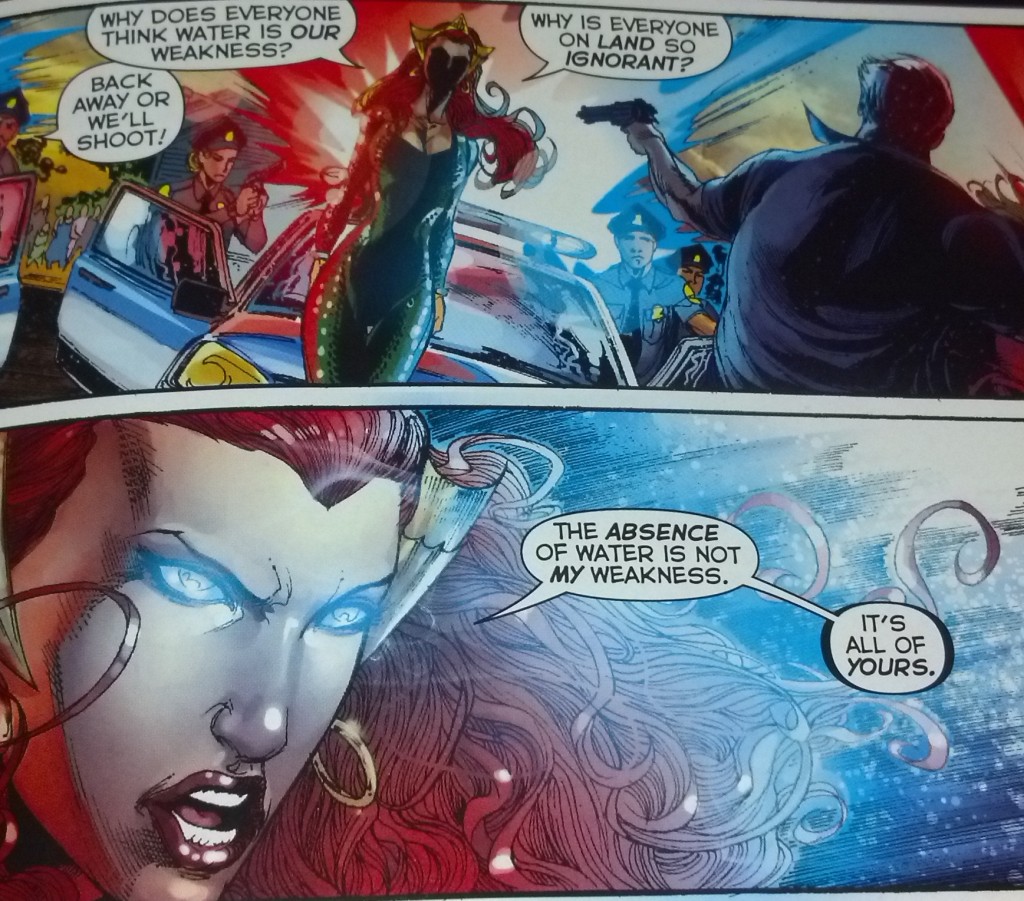
Aquaman Volume 1: The Trench is a compelling, well-paced story with characters that are complex, interesting,and well-developed. There are hints throughout of a deeper story, and clues to a backstory that I suspect will gradually be revealed. It’s smart, funny, and the reader (especially an ocean-loving reader) can easily connect to Aquaman’s motives. This is a great reboot of the Aquaman franchise and worth a read.
Unfortunately, the science is terrible.
When I saw that the title of this volume was The Trench, I expected to see my favorite marine ecosystem, deep-sea hydrothermal vents, and I was not disappointed. The Mid-Atlantic Ridge plays a central role as the story unfurls. Sadly, its role is as the focal point for some serious biogeographic and geological fallacies.
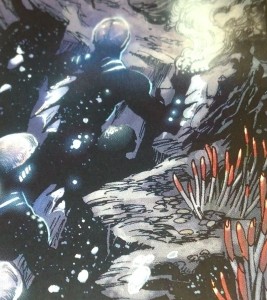
Let’s start at the beginning, since the first problem appears on page 1. Here we see the unnamed antagonists rise from the “trench”, a hydrothermally active region of the Mid-Atlantic Ridge. We know we’re near a hydrothermal vent because we see tube worms, most likely Riftia pachyptila. Unfortunately, Riftia pachyptila don’t live anywhere near the Mid-Atlantic Ridge.
Giant tubeworms may be the most iconic hydrothermal vent organisms, but they only occur along the East Pacific Rise, thousands of kilometers and an ocean away from the Mid-Atlantic. A Mid-Atlantic vent should be swarming with eyeless shrimp, Rimicaris exoculata. Although completely blind, Rimicaris exoculata possess a dorsal organ that allows them to detect black-body radiation emitted by the hydrothermal vents.
The ability to see by the light of a hydrothermal vent would have been a handy power for Aquaman to use during this adventure. Instead, he commanded a swarm of anglerfish to light the way for him with bioluminescence. I’ll admit it is pretty awesome seeing a variety of beautifully illustrated, respectably accurate Lophiiformes and hatchetfish surrounding our heroes. Unfortunately, there are two problems with Aquaman’s plan. First, anglerfish use their bioluminescence to lure prey while hatchetfish use it to camouflage themselves. Neither produces enough light to see by, even for an Atlantean. Second, mid-water and deep-sea fish are not common and are relatively slow swimmers. To accumulate that many in one place would take hours, if not days, and even if they were summoned, Aquaman and Mera would be plumbing the depths at an agonizingly slow pace while they wait for their illuminated entourage.
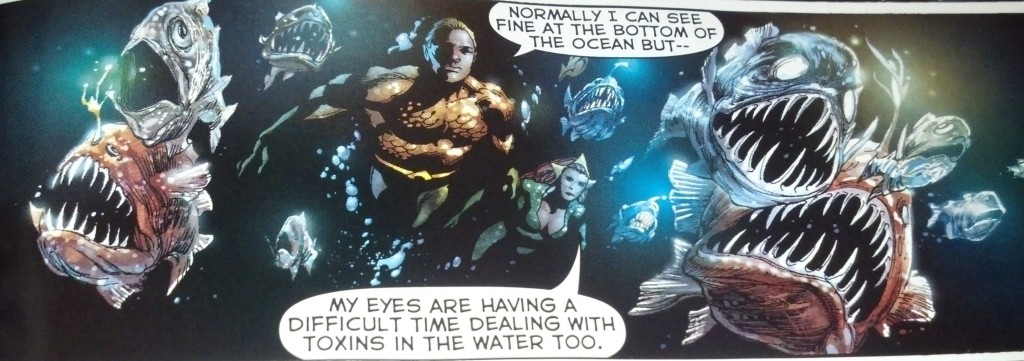
Finally, Aquaman defeats his foes by hurling his trident into the vent, triggering a volcanic eruption. Hydrothermal vents are driven by the same tectonic processes that produce volcanism, and there can be volcanoes associated with hydrothermal activity, but vents are not volcanoes. The magma body that drives hydrothermal activity is deep below the earth’s crust. A quick jab with a trident wouldn’t release lava or trigger a volcanic eruption.
Lest you think I’m a spoil-sport out to dump on comic book science, the writer did get many things right. As I said earlier, the angler- and hatchetfish look beautiful. Early on, Aquaman’s frienemy, Dr. Shin, hypothesizes that sulfide residue on the gills of one of the creatures was produced by a black smoker. Aquaman even channels his inner population geneticist by expounding on the effects of inbreeding depression on a severely bottlenecked population.
A good story, compelling characters, clever dialog, and fantastic artwork make this series one to read. All it lacks is the careful eye of a marine scientist to help with some of the details. It’s worth noting that, for every fantastical sea monster you could imagine, a seasoned marine ecologists could summon ten even more bizarre animals that actually exists. You know, just in case DC is in the market for a consultant.
Other Posts in the Science of Aquaman Series:

Wouldn’t it have been cool if DC had rebooted Aquaman as the diminished male consort of Mera, and given her all the powers, with him just hanging off her (and a backstory for that)? Osedax, Xylophaga and deep-sea angler fish can’t all be wrong…
Or how about AC and Mera as a perpetually-paired simultaneous- hermaphrodite couple, like Paroriza pallens?
This comment has been reviewed by a panel of anonymous scientific peers. We find the proposal of Jon C to be exceptionally awesome.